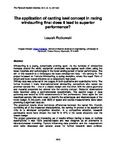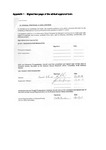The application of canting keel concept in racing windsurfing fins: does it lead to superior performance?
| dc.contributor.author | Rutkowski, L. | |
| dc.date.accessioned | 2019-05-13T14:47:14Z | |
| dc.date.available | 2019-05-13T14:47:14Z | |
| dc.date.issued | 2010 | |
| dc.identifier.citation |
Rutkowski, L. (2010) 'The application of canting keel concept in racing windsurfing fins: does it lead to superior performance?', The Plymouth Student Scientist, p. 207-233. | en_US |
| dc.identifier.issn | 1754-2383 | |
| dc.identifier.uri | http://hdl.handle.net/10026.1/13904 | |
| dc.description.abstract |
Windsurfing is a young, dynamically evolving sport. As the numbers of windsurfers increase around the world, equipment producers race against each other, using the latest materials and technologies in the never ending pursuit of better performance. The aim of this research is to investigate the latest development idea – the canting fin. The project is based on Formula Windsurfing, a racing discipline, where fins reach 70cm of length and have crucial influence on a competitor’s final result. Primary data was collected in two stages, in both qualitative and quantitative forms. The former involved 4 male, international-level windsurfing competitors who tested two provided sample fins – one of a classic design and the other, with the same geometry and material properties but altered into the canting concept. Subjects’ observations were recorded using a semi-structured questionnaire. The second stage of data gathering was based on GPS measurements of fins’ performance. Once again the two described sample foils were used to identify the advantages and disadvantages of the novel design. At this point, over 5000 of speed and course measurements were taken providing a significant data set. The presented results show numerous differences between the tested fins. Overall, combining all of the measured characteristics, the canting fin proved to be superior by 44% in a simulated competition situation. In a competitive situation, research participants would have chosen the new fin in 87% of the tested situations over the classic design. The project generated an interesting set of results without having to base on multiple assumptions. It was 100% practise-based and was designed as an alternative to laboratory-based modelling. Factors influencing data precision and the measurement error were discussed and several areas for further research were outlined. | en_US |
| dc.language.iso | en | en_US |
| dc.publisher | University of Plymouth | |
| dc.rights | Attribution 3.0 United States | * |
| dc.rights.uri | http://creativecommons.org/licenses/by/3.0/us/ | * |
| dc.subject | Windsurfing | en_US |
| dc.subject | windsurfers | en_US |
| dc.subject | canting keel concept | en_US |
| dc.subject | GPS | en_US |
| dc.subject | performance | en_US |
| dc.subject | water | en_US |
| dc.subject | racing | en_US |
| dc.subject | fins | en_US |
| dc.subject | windsurfing fins | en_US |
| dc.title | The application of canting keel concept in racing windsurfing fins: does it lead to superior performance? | en_US |
| dc.type | Article | |
| plymouth.issue | 1 | |
| plymouth.volume | 3 | |
| plymouth.journal | The Plymouth Student Scientist |




